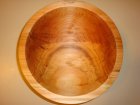We were heading out and saw that the power company had just cut down a large willow tree. The owner of the property said "come get all you want!"
So I got 6 chunks; I cut them to rough length. Some were 26" across. I'm just wondering who has turned this stuff before and should I be looking out for anything?
Strange thing is the center is actually reddish in color. The picture doesn't show the largest ones as I had to go back with help.

So I got 6 chunks; I cut them to rough length. Some were 26" across. I'm just wondering who has turned this stuff before and should I be looking out for anything?
Strange thing is the center is actually reddish in color. The picture doesn't show the largest ones as I had to go back with help.




